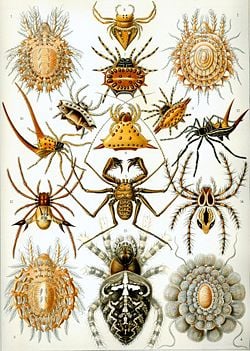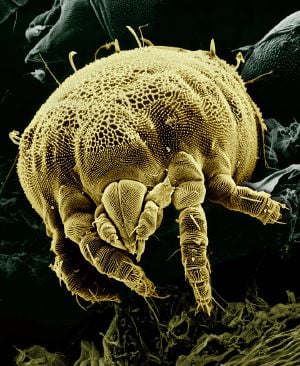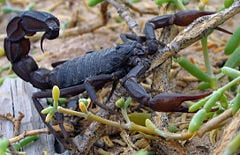| Arachnid | ||||||||
|---|---|---|---|---|---|---|---|---|
 "Arachnida" from Ernst Haeckel's Kunstformen der Natur, 1904
| ||||||||
| Scientific classification | ||||||||
| ||||||||
|
See text. |
An arachnid is any member of the arthropod class Arachnida, a largely terrestrial group that includes spiders, mites, ticks, scorpions, and harvestmen (daddy longlegs). Arachnida is one of the classes of the subphylum Chelicerata (including horseshoe crabs, sea scorpions, and sea spiders) of the phylum Arthropoda. Arachnids are characterized by four pairs of segmented walking legs and a body divided into two regions, the cephalothorax and the abdomen.
Despite the fact that the sight of arachnids often evokes fear or loathing in many people (arachnophobia, or an abnormal fear of spiders, is one of the more common phobias), arachnids actually perform valuable roles in the ecosystem. They also provide benefit to people, helping to control pest insects and adding to the sense of wonder of nature. Most arachnids are unlikely to bite humans, who they do not see as prey.
The importance of lineage in classification is seen in the groups included in arachnids, for the mites and so other taxa do not have the characteristic segmented bodies of Arachnida, but are considered to have been derived from early forms with segmented bodies.
Overview
As arthropods (phylum Arthropoda), the arachnids are characterized by the possession of a segmented body, a pair of jointed appendages on each segment, and an exoskeleton. The hard exoskeleton is made out of protein and a tough polysaccharide called chitin. Periodically, an arachnid must shed this covering when it molts.
As arthropods, arachnids are also characterized by a dorsal heart, a ventral nervous system, an open circulatory system, and a digestive system.
The subphylum Chelicerata, to which arachnids belong, is one of the major subdivisions of the phylum Arthropoda. Most of the marine chelicerates are now extinct. In the Chelicerata, the body is divided into an anterior prosoma (or cephalothorax) composed of eight segments plus a presegmental acron and a posterior opisthoma (or abdomen), composed of twelve segments plus a postsegmental telson. In some celicerates, the segments are considered to have been lost, and daddy longlegs, ticks, and mites do not have segmented bodies.
The chelicerae, which give the group its name, are pointed appendages that grasp the food in place of the chewing mandibles most other arthropods have. The chelicerae serve to macerate food particles. In some arachnids, the first post-oral pair of appendages—pedipalps (leg-like mouthparts)—of some species have been adapted for sensory, prey capture, or reproductive functions. In Solifugae, the palpi are quite leg-like and make Solifugae appear to have ten legs instead of eight.
Arachnids may be easily distinguished from insects by the fact that arachnids have eight legs whereas insects have six. The larvae of mites have only six legs; the fourth pair appears when they molt into nymphs. Some adult mites also have fewer than four pairs of legs. Arachnids are further distinguished from insects by the fact they have no antennae and no wings. They have a two-segmented body, made up of a cephalothorax and an abdomen, the cephalothorax being derived from the fusion of the cephalon (head) and the thorax.
Arachnids are chiefly terrestrial invertebrates, comprising some 65,000 to 73,000 named species, including spiders, scorpions, harvestmen, ticks, and mites.
Arachnids are mostly carnivorous, feeding on the pre-digested bodies of insects and other small animals. Many are venomous—they secrete poison from specialized glands to kill prey or enemies. Others are parasites, some of which are carriers of disease.
Arachnids usually lay eggs, which hatch into immature adults.
Arachnids are named after the mythological figure Arachne.
Major groups
Spiders
Spiders are predatory invertebrate animals that comprise the order Araneae, one of several orders within the larger class of arachnids. They have two body segments, eight legs, no chewing mouth parts, and no wings. All spiders produce silk, a thin, strong protein strand extruded by the spider from spinnerets most commonly found on the end of the abdomen. Many species use it to trap insects in webs, although there are many species that hunt freely. Silk can be used to aid in climbing, form smooth walls for burrows, build egg sacs, wrap prey, and temporarily hold sperm, among other applications.
All spiders except those in the families Uloboridae and Holarchaeidae, and in the suborder Mesothelae, can inject venom to protect themselves or to kill and liquefy prey. Only about 200 species, however, have bites that can pose health problems to humans (Diaz 2004). Many larger species' bites may be painful, but will not produce lasting health concerns.
Harvestmen
The Phalangids (legacy name) or Opiliones (better known as "harvestmen") are arachnids belonging to the order Opiliones. As of 2005, over 6,300 species of Phalangids have been discovered worldwide. Well-preserved fossils have been found in the 400-million year old Rhynie cherts of Scotland, which looks surprisingly modern, indicating that the basic structure of the harvestmen has not changed much since then. In some places, harvestmen are known by the name "daddy longlegs" or "granddaddy longlegs."
Scorpions
Scorpions are arachnids belonging to the order Scorpiones. The scorpion's tail comprises six segments, the last containing the scorpion's anus and bearing the telson (the sting). The telson, in turn, consists of the vesicle, which holds a pair of venom glands and the hypodermic aculeus, the venom-injecting barb.
Mites and ticks
Acarina or Acari are a taxon of arachnids that contains mites and ticks. The diversity of the Acari is extraordinary and its fossil history goes back to the Devonian era. Most acarines are minute to small (e.g. 0.080-1.00mm), but the giants of the Acari (some ticks and red velvet mites) may reach lengths of ten to 20 mm. It is estimated that over 50,000 species have been described (as of 1999) and that a million or more species are currently living. The study of mites and ticks is called acarology (Walter and Proctor 1999).
As members of Arachnida, mites should have a segmented body with the segments organized into two tagmata: a prosoma (cephalothorax) and an opisthosoma (abdomen). However, only the faintest traces of primary segmentation remain in mites, the prosoma and opisthosoma are insensibly fused, and a region of flexible cuticle (the cirumcapitular furrow) separates the chelicerae and pedipalps from the rest of the body. Most adult mites have four pairs of legs, like other arachnids, but some have fewer. For example, gall mites like Phyllocoptes variabilis (superfamily Eriophyioidea) have a wormlike body with only two pairs of legs; some parasitic mites have only one or three pairs of legs in the adult stage. Larval and prelarval stages have a maximum of three pairs of legs; adult mites with only three pairs of legs may be called 'larviform'.
Classification
- Trigonotarbida - extinct
- Amblypygi - "blunt rump" tailless whip scorpions with front legs modified into whip-like sensory structures as long as 25 cm or more
- Araneae - spiders (40,000 species)
- Mesothelae - very rare, basal spiders, with abdomen segmented and spinnerets median
- Opisthothelae - spiders with abdomen unsegmented and spinnerets located posteriorly
- Araneomorphae - most common spiders
- Mygalomorphae - tarantulas and tarantula-like spiders
- Phalangiotarbida - extinct
- Opiliones - phalangids, harvestmen or daddy-long-legs (6,300 species)
- Palpigradi - microwhip scorpions
- Pseudoscorpionida - pseudoscorpions
- Ricinulei - ricinuleids, hooded tickspiders
- Schizomida - "split middle" whip scorpions with divided exoskeletons
- Scorpiones - scorpions (2,000 species)
- Solifugae - solpugids, windscorpions, sun spiders or camel spiders (900 species)
- Haptopoda - extinct
- Uropygi - whip scorpions, with first legs modified as whip-like sensory organs and with a long thin tail at end of abdomen (100 species)
- Acarina - mites and ticks (30,000 species)
- Acariformes
- Sarcoptiformes
- Trombidiformes
- Opilioacariformes
- Parasitiformes - holothyrans, ticks and mesostigmatic mites
- Acariformes
Arachnids in human culture
Arachnids since ancient times have captured the human imagination, for example as objects of superstitious fear.
Arachnids make their appearance in the Western zodiac, in the constellation of Scorpius. They are also present in the Egyptian hieroglyphs and diverse mythological characters such as the Greek Arachné and the west African Anansi. There are a number of gods based on arachnids, such as the Egyptian Serket. Images of scorpion-men are present in Assyrian reliefs.
ReferencesISBN links support NWE through referral fees
- Diaz, J. H. The global epidemiology, syndromic classification, management, and prevention of spider bites American Journal of Tropical Medicine and Hygiene 71(2): 239-250, 2004. Retrieved October 1, 2007.
- Maddison, D. R. Arachnida. Spiders, mites, scorpions, whipscorpions, pseudoscorpions Tree of Life Web Project, 1995.
- Walter, D. E., and H. C. Proctor. Mites: Ecology, Evolution and Behaviour. Sydney: University of NSW Press, 1999. ISBN 0868405299
Credits
New World Encyclopedia writers and editors rewrote and completed the Wikipedia article in accordance with New World Encyclopedia standards. This article abides by terms of the Creative Commons CC-by-sa 3.0 License (CC-by-sa), which may be used and disseminated with proper attribution. Credit is due under the terms of this license that can reference both the New World Encyclopedia contributors and the selfless volunteer contributors of the Wikimedia Foundation. To cite this article click here for a list of acceptable citing formats.The history of earlier contributions by wikipedians is accessible to researchers here:
- Arachnida history
- Chelicerata history
- Spider history
- Opiliones history
- Scorpion history
- Acarina history
The history of this article since it was imported to New World Encyclopedia:
Note: Some restrictions may apply to use of individual images which are separately licensed.

